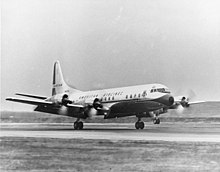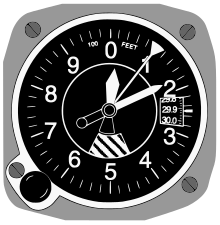American Airlines Flight 320
On February 3, 1959, the Lockheed L-188 Electra performing the flight crashed into the East River during its descent and approach to LaGuardia Airport, killing 65 of the 73 people on board.
American Airlines had been flying the newly-developed Lockheed Electra in commercial service for only about two weeks before the crash, and the accident was the first involving the aircraft type.
The Air Line Pilots Association disputed the conclusion, blaming the accident on faulty instruments in the aircraft and on poor weather conditions, not on any mistakes made by the highly experienced flight crew.
The airline had first started flying the Electra in commercial service on January 23, 1959, and it offered six daily round-trip flights on its route between New York and Chicago, with plans to deploy the new aircraft to other destinations once Lockheed was able to deliver more.
[1][2][3] The new planes, which carried seventy passengers, were faster than the company's Douglas DC-7 aircraft that it had been using on the route, and shortened the flight from Chicago to New York by half an hour.
[4] On the evening of February 3, 1959, the flight was scheduled to leave Chicago's Midway Airport at 9:00 p.m. EST, but wind-driven snow delayed its departure.
[7]: 2 [8] The controller instructed the flight to proceed to the north of the airport, and to prepare to perform a direct approach to Runway 22 over the East River.
[9] The accident was the first crash involving the Lockheed L-188 Electra aircraft, which had begun commercial service at American Airlines in the previous weeks.
[12][15] In the darkness and the fog, rescuers could hear the cries of survivors, but poor visibility and swift river currents made recovery of the victims of the crash extremely difficult.
[13] In Washington, D.C., the Civil Aeronautics Board (CAB) dispatched two investigators as soon as authorities became aware of the crash, and ordered the airline's records to be impounded.
[6] After the two and a half hour meeting, it formed a special House subcommittee to investigate the crash and the overall safety issues raised by the transition to jet and turboprop aircraft.
[7]: 25 [31] A resident of Decatur, Michigan, he was qualified to fly all of the aircraft that had been operated by American Airlines and was considered one of the most experienced commercial pilots in the world, with seven million miles flown.
[6] He suffered fractures to his jaw, pelvis, and both legs in the crash as well as internal injuries, but eventually recovered and returned to work at American Airlines.
[39] The investigators had to wait to talk to first officer Frank Hlavacek because of his injuries, but several days later he told them that he had been calling out altimeter readings to Captain DeWitt during the descent in one-hundred-foot (30 m) increments as they approached the runway.
[41][42] On the day after the crash, crews attempted to use salvage cranes to raise the fuselage of the aircraft out of the river, but they were only briefly successful before the wreckage broke apart and most of it fell back into the water.
[45] In response to the accident, on February 9, the FAA increased the minimum visibility requirements for Lockheed Electra landings during poor weather conditions.
[9] The Kollsman Instrument Corporation, which built both types, described the new style as a "precision drum altimeter" and said that it had been "developed as a result of a human engineering study made by the Aero Medical Laboratory, by an unnamed government body, and at the instigation of the Air Force, primarily to meet the needs of faster flying.
[49] On February 20, 1959, the FAA extended the restrictions to cover Boeing 707 aircraft that had been equipped with the new-style altimeters, citing unspecified "operational difficulties in the last few days".
In testimony before the board, first officer Hlavacek repeated the information that he had given in his earlier interviews, testifying that he and the other crew members had compared their altimeters several times during the flight, including when they passed Newark, New Jersey.
The CAB heard from experts from the Lockheed Aircraft Corporation who had attempted to reproduce a 500-foot error in the reported altitude by simulating a buildup of ice in the air pressure lines that provide the input data to the altimeters.
It also mentioned the poor weather conditions in the approach area and lack of visual references, causing the crew to misinterpret their height and altitude.
[7]: 6 However, because the lights were slanted upward at between three and five degrees, and because of a dike located between the end of runway 22 and the water, the CAB concluded that they would not have been visible to the crew because of the aircraft's premature descent below the cloud level.
[7]: 20 The CAB's conclusions were soundly criticized by the president of the Air Line Pilots Association, who called the report "grossly inaccurate in a number of respects".
He said that all of the pilots at American Airlines were united in their criticism of the report, saying it "slandered and wrongfully accused" crew members of the plane, and was aimed at "conveniently writing the accident off the books" rather than accurately determining a cause.
House Commerce Committee Chairman Oren Harris of Arkansas said the subcommittee would look at some aspects of the new aircraft, including the equipment that was being used and the training of the pilots.
[20] The seven members of the subcommittee visited LaGuardia Airport on February 12 and inspected the runway where Flight 320 had been approaching, but refused to publicly discuss the results of their investigation.
[62] During hearings of the aviation subcommittee of the Senate Commerce Committee in January 1960, the safety director for the CAB testified that if high intensity lights had been present at the LaGuardia runway, "the accident probably would not have happened".
As a result of the testimony, three of the senators on the subcommittee asked for the installation of modern lighting systems at Chicago's Midway Airport and other landing fields, and for new regulations that required copilots to be certified on the aircraft they fly.
[64] Citing the lessons from the crash of American Airlines Flight 320, in March 1960, the FAA and the New York Port Authority announced plans to add approach lights and an instrument landing system to runway 22 at La Guardia Airport.
[72] The Air Transport Association complained that the minor improvement to crash investigations was not worth the installation expense and extra weight of the recorders.



